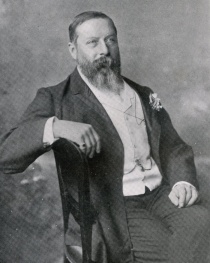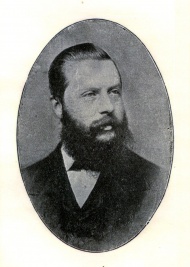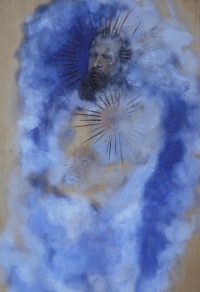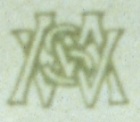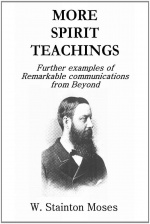William Stainton Moses
William Stainton Moses (originally Moseyn) (November 5, 1839 - September 5, 1892) was an English clergyman, writer, and editor. He was a medium and a prominent member of the Spiritualist group in England, as well as a member of the Theosophical Society. He had a guide called "Imperator," whose nature is discussed in the Mahatma Letters. Stainton Moses frequently used the pen name of M.A. Oxon.
Madame Blavatsky produced a precipitated painting of him in New York with Colonel Olcott present.
Early life and career
William Stainton Moses was born on November 5, 1839, in Donnington in Lincolnshire, England. He was educated at Bedford School, University College School, London and Exeter College, Oxford, where he earned a Master of Arts degree.
He was ordained as a priest of the Church of England, and at age 24 began his ministry at Kirk Maughold, near Ramsey, in the Isle of Man. There he was well regarded by parishioners, who appreciated his active aid during a smallpox outbreak. After four years he moved to St. George's, another church on the Isle of Man. During these years he also began to submit articles for popular periodicals such as Punch. In 1870 he took a position as curate in Dorsetshire, but recurring health challenges forced him to abandon parish work. He spent the next seven years tutoring the son of Stanhope Templeman Speer, the doctor who had helped him recover from illness.[1]
In 1871 he became a lecturer in philology at University of London, and a Professor of Classics and English at the University College School in London.[2]
Spiritualism
Rev. Stainton Moses became interested in Spiritualism. He attended his first séance with Lottie Fowler in 1872. Five months after his introduction to spiritualism, he reported to have had his first experience of levitation. Eventually, he developed remarkable psychic abilities and began to publish the information that came through his automatic writing in his books. He became one of the most respected and leading figures among Spiritualists.
In her book The Key to Theosophy, H. P. Blavatsky wrote that he was "the only true Spiritualist I know of, though we may still disagree with him on many a minor question. Apart from this, no Spiritualist comes nearer to the occult truths than he does."[3]
Imperator
One of Stainton Moses' "controls" or spirit guides was called "Imperator". He first identified himself under this name on September 19, 1872, but later, yielding to entreaties by Moses, he revealed, on July 6, 1873, in Book IV of his writings that he was the biblical prophet Malachi. His communications were not written by Imperator himself, but by "Rector." The signature was "Imperator S. D. (Servus Dei)" or "I.S.D.," preceded by a Latin cross at first, then later by a crown.[4]
In The Mahatma Letters Imperator is frequently designated by the cross "+". Since in some occasions he claimed to know nothing about "the Brothers", Moses did not believe in their existence.
Imperator's identity is not clear. In letter No. 38, Master K.H. suggests that different entities communicated with Moses under that name, sometimes it being his own Higher Self, at other times one of the Adepts, and in other occasions some other entity or entities. In 1882 the Master refers to Imperator as a "high disembodied shell, that he [Stainton Moses] mistakes for the "Imperator" of the early days of his mediumship".[5] Regarding the influence of (the original) Imperator on him, Master K.H. wrote in 1881:
Whenever under the influence of Imperator he is all alive to the realities of Occultism, and the superiority of our Science over Spiritualism. As soon as left alone and under the pernicious guidance of those he firmly believes having identified with disembodied Souls — all becomes confusion again! His mind will yield to no suggestions, no reasonings but his own, and those are all for Spiritualistic theories. . . . It is but when standing face to face with his inner Self that he realizes the truth that there is something higher and nobler than the prittle-prattle of pseudo Spirits. It was at such a moment that he heard for the first [time] the voice of Imperator, and it was, as he himself puts it: “as the voice of God speaking to his inner Self.” That voice made itself familiar to him for years, and yet he very often heeds it not.[6]
Theosophical involvement
Stainton Moses contacted Col. Olcott early 1875, before the founding of the Theosophical Society, and became a close friend of him and H. P. Blavatsky. On June 29, 1876, he was admitted to the Society.[7] In the autumn of 1876 Mme. Blavatsky precipitated a painting that showed Mr. Moses' progress in his attempt to consciously project his Double. In October of that year he was put on probation by one of the Masters of Wisdom. However, he always attributed all his inner experiences to the action of disembodied "spirits" and could not quite accept the existence of the Masters.
S. Moses was interested in belonging to a secret society in London, preferably with some kind of masonic ritual, to discuss "the deeper mysteries of Theosophy" and "to have esoteric phenomenal experiences".[8] Although the T.S. did not fulfill all his expectations, he thought it the best available option. On December 11, 1877, he became one of the founders of the "British Theosophical Society" which would be known later as the London Lodge. However, he soon realized that he was not going to find in the Society what he wanted and became critical of the organization and its Founders. Although he was not satisfied with the Society he maintained a connection with it until his resignation in 1884, after the Kiddle Incident.
During Col. Olcott's visit to London in 1888 he came again close to the Founders and agreed on working together. He proposed that if the Colonel "would manage to keep H.P.B. in a gentle mood towards Spiritualists, he would use his best influence with the latter to come to a more brotherly understanding with the Theosophists".[9] The arrangement however had to be put to an end due to the Spiritualists strong reaction against Mr Moses' support of Theosophy.
Col. Olcott always regarded him as his "dear old friend" and held him in high regard, as "the most brilliant of the writers on Spiritualism".[10] He wrote:
He was a man to love, respect, and trust; a friend that one could ever count upon in all emergencies. He had a commanding influence among Spiritualists, one due to the elevation of his personal character quite as much as to his ripe scholarship and his thorough acquaintance with the literature and different aspects of psychical science. His views were broad and catholic upon those subjects, and, but for the bigotry of the majority of Spiritualists, he and I would have gone far towards our establishing those friendly relations between our two parties that in reason should subsist.[11]
Mahatma Letters
Here is the letterhead and crest of Rev. Stainton Moses from his 1881 letter to A. P. Sinnett, to which Mahatma Koot Hoomi added remarks.
Rev. Stainton Moses is mentioned in several of The Mahatma Letters to A. P. Sinnett. Master K.H. wrote:
His is a weird, rare nature. His occult psychical energies are tremendous; but they have lain dormant, folded up within him and unknown to himself, when, some eight years or so, Imperator threw his eye upon him and bid his spirit soar. Since then, a new life has been in him, a dual existence, but his nature could not be changed. Brought up as a theological student, his mind was devoured by doubts. . . . His mind is too positive. Once impressed it becomes easier to efface characters engraved upon titanium than impressions made upon his brain.[12]
In the letters we find evidence that he was in touch with one of the Masters of Wisdom and was being helped in his training, although he was not aware of it. As Master K.H. wrote:
In every letter of his he clamoured for a "living Brother." To her [Mme. Blavatsky's] unequivocal statement that there was one already having charge of him, he strongly objected. When helped to get free from his too material body, absent from it for hours and days sometimes his empty machine run during that period from afar and by external, living influence—as soon as back, he would begin labouring under the irradicable impression of having been all that time the vehicle for another intelligence, a disembodied not embodied Spirit, truth never once flashing across his mind.[13]
Being essentially a Spiritualist, he attributed all his inner experiences to the action of disembodied "spirits".
From the letters is also evident that he was put on probation. The Master wrote:
In October, 1876, they [the Brothers of the Shadow] had begun their work upon him. "I am fighting" — he wrote — "a hand to hand battle with all the legions of the Fiend for the past three weeks. My nights are made hideous with their torments, temptations and foul suggestions. I see them all around, glaring at me, gabbling, howling, grinning! Every form of filthy suggestion, of bewildering doubt, of mad and shuddering fear is upon me . . . I can understand Zanoni's Dweller now . . . I have not wavered yet . . . and their temptations are fainter, the presence less near, the horror less. . . ."
One night she [i.e., Mme. Blavatsky] had prostrated herself before her Superior, one of the few they fear, praying him to wave his hand across the ocean, lest S.M. should die, and the Theos. Soc. lose its best subject. "He must be tried" was the answer.[14]
Mr. Sinnett copied some of the remarks the Master made on Mr. Moses and sent them to him, which made him very upset. On November 26, 1881, Mr. Moses wrote a letter addressed to Mr. Sinnett in which he discussed his mediumship. This letter is published as letter number 38 in the chronological sequence of The Mahatma Letters to A.P. Sinnett (number 90 in Barker editions).
In spite of his criticisms, the Master regarded him as "the best, the most reliable of mediums".[15]
Later years
In 1881 and 1882, Moses helped to found the Society for Psychical Research. In 1884, Moses was a founding member, together with Rogers, of the London Spiritualist Alliance, afterwards the College of Psychic Studies.
He died on September 5, 1892.
Writings
Rev. Stainton Moses became publisher and editor of the periodical Light. He wrote for spiritualistic and Theosophical journals under the nom-de-plume M. A. (Oxon.)[16] reflecting his academic credentials, where Oxon. is an abbreviation for the University of Oxford (Latin name Universitas Oxoniensis).
The "Early Story of TS" was an article published in two parts in Light, July 9, 1892, pp. 330-32; and July 23, 1892, pp. 354-57. In this article Moses reviewed Olcott's Old Diary Leaves when they were first published in The Theosophist beginning with the March 1892 issue. Moses also published a transcription of eight letters that he received from Olcott during the years 1875-76. Some of the letters give Colonel Olcott's early views of Madame Blavatsky.[17]
Stainton Moses wrote these books and pamphlets, listed chronologically:
- The Slade Case: Its Facts and Its Lessons. A Record and a Warning. London: J. Burns, 1877. Pamphlet.
- Psychography: a Treatise on One of the Objective Forms of Psychic or Spiritual Phenomena. London: W.H. Harrison, 1878. Available at Hathitrust.
- Spirit Identity. London, W.H. Harrison, 1879. London: London Spiritualist Alliance, 1902. Later editions.
- Higher Aspects of Spiritualism. London: E.W. Allen & Co. ; Boston: Colby & Rich ; Chicago: Religio-Philosophical Publishing House, 1880. London: London Spiritualist Alliance, 1908.
- Spirit Teachings. London, Psychological Press Association, 1883. Memorial edition - London, London Spiritualist Alliance, 1898. "Through the mediumship of William Stainton Moses (M.A. Oxon)." Available at Hathitrust. There were many printings and at least 9 editions. Dutch translation, 1891. French translation, 1899.
- The Mystic Voices of Heaven: or, The Supernatural Revealed in the Natural Science of the Heavens. London: Elliot Stock, 1886.
- More Spirit Teachings. London: L.N. Fowler, Camelot Press, 1892. With other authors. Several editions.
He was also involved in these works:
- Gregory, William. Animal Magnetism, or, Mesmerism and Its Phenomena. 1st edition about 1877. Introductions by Stainton Moses appeared in 3rd and later editions. 3rd, and slightly rev. and abridged, ed. - London: Psychological Press Association, and E.W. Allen, 1884. 4th edition - London: G. Redway, 1898. London: Nichols & Co., 1909. Many more editions and printings.
See also
Online resources
Articles
- Early Story of TS by William Stainton Moses
- Colonel Olcott on the Kiddle Plagiarism by "M.A. (Oxon.)"
- William Stainton Moses at Theosopedia.
- William Stainton Moses Biography at Spiritwritings.com
- "Imperator" at Gale Encyclopedia of Occultism & Parapsychology.
Additional resources
Articles
- Hamill, John, "Additional Light on William Stainton Moses and The Theosophical Society", Theosophical History, Volume 7, (July 1999).
Books
- Bennett, Edward T. Psychic Phenomena: A Brief Account of the Physical Manifestations Observed in Psychical Research. New York: Brentano's, 1909. Available at Project Gutenberg and Hathitrust.
- Buckland, Raymond. The Spirit Book: the Encyclopedia of Clairvoyance, Channeling, and Spirit Communication. Canton, Mich.: Visible Ink, 2006.
- Leaf, Horace. The World's Greatest Mediums. London, Spiritualist Association of Great Britain, 1966.
- Lillie, Arthur. Modern Mystics and Modern Magic; containing a full biography of the Rev. William Stainton Moses, together with sketches of Swedenborg, Boehme, Madame Guyon, the Illuminati, the kabbalists, the theosophists, the French spiritists, the Society of Psychical Research, etc.. New York: C. Scribner's Sons, 1894. Available at Hathitrust.
- Oppenheim, Janet. The Other World: Spiritualism and Psychical Research in England, 1850-1914. Cambridge: Cambridge University Press, 1985 .
- Trethewy, A. W. The "controls" of Stainton Moses ("M. A. Oxon."). London: Hurst & Blackett, 1923.
- Vice, Diana. The Stainton-Moses Communications through Diana Vice. Taunton (Nethercot Mill, Combe Florey, Taunton, Somerset: Martigan Publications, 1973. Purporting to be communications received by the South African medium, Diana Vice, from alleged spirit entities, under the control of one presumed to be the late Rev. William Stainton-Moses.
Notes
- ↑ William Stainton Moses Biography, at Spiritwritings.com
- ↑ The International Theosophical Year Book 1938 (Adyar, Madras, India: Theosophical Publishing House, 1938): 202.
- ↑ Helena Petrovna Blavatsky, The Key to Theosophy (Pasadena, CA: Theosophical Universtity Press, 1972), ???.
- ↑ "Imperator" at Gale Encyclopedia of Occultism & Parapsychology.
- ↑ Vicente Hao Chin, Jr., The Mahatma Letters to A.P. Sinnett in chronological sequence No. 93b (Quezon City: Theosophical Publishing House, 1993), 329.
- ↑ Vicente Hao Chin, Jr., The Mahatma Letters to A.P. Sinnett in chronological sequence No. 18 (Quezon City: Theosophical Publishing House, 1993), ???.
- ↑ Theosophical Society General Membership Register, 1875-1942 at http://tsmembers.org/. See book 1, entry 93 (website file: 1A/12).
- ↑ Hamill, John, "Additional Light on William Stainton Moses and The Theosophical Society", Theosophical History, Volume 7, (July 1999), p. 252-253.
- ↑ Henry Steel Olcott, Old Diary Leaves Fourth Series (Adyar, Madras: The Theosophical Publishing House, 1974), 479.
- ↑ Henry Steel Olcott, Old Diary Leaves Fourth Series (Adyar, Madras: The Theosophical Publishing House, 1974), 389.
- ↑ Henry Steel Olcott, Old Diary Leaves Fourth Series (Adyar, Madras: The Theosophical Publishing House, 1974), 479.
- ↑ Vicente Hao Chin, Jr., The Mahatma Letters to A.P. Sinnett in chronological sequence No. 18 (Quezon City: Theosophical Publishing House, 1993), ???.
- ↑ Vicente Hao Chin, Jr., The Mahatma Letters to A.P. Sinnett in chronological sequence No. 18 (Quezon City: Theosophical Publishing House, 1993), ???. See also Mahatma Letter No. 18#Page 8.
- ↑ Vicente Hao Chin, Jr., The Mahatma Letters to A.P. Sinnett in chronological sequence No. 18 (Quezon City: Theosophical Publishing House, 1993), ???.
- ↑ Vicente Hao Chin, Jr., The Mahatma Letters to A.P. Sinnett in chronological sequence No. 93b (Quezon City: Theosophical Publishing House, 1993), 329.
- ↑ The International Theosophical Year Book 1938 (Adyar, Madras, India: Theosophical Publishing House, 1938): 202.
- ↑ Available at Theosophical Society in America Web page [1] and at the Blavatsky Archives Web page. [2]
